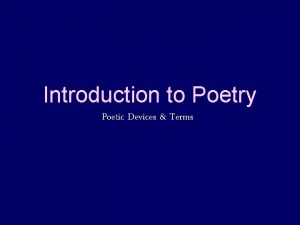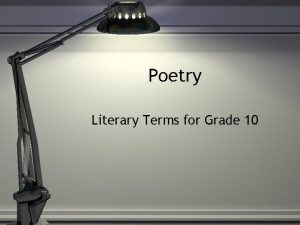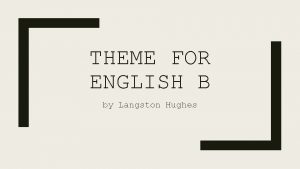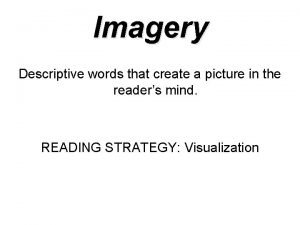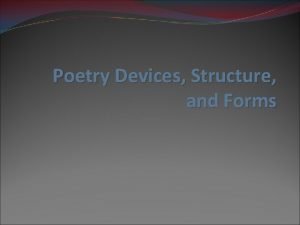LITERARY DEVICES 9 th Grade English Imagery Descriptive







- Slides: 7

LITERARY DEVICES 9 th Grade English

Imagery Descriptive words and phrases that recreate sensory experiences for the reader. Imagery usually appeals to the five senses-- sight, hearing, smell, taste, and touch—to help the reader imagine exactly what is being described. Example: Walls of thick vegetation rose up on all sides and arched overhead in a lacy canopy that filtered the light to a soft shade. It had just rained; the air was hot and steamy. I felt enclosed in a semitropical terrarium, sealed off from a world that suddenly seemed a thousand miles away. ” - From Midnight in the Garden of Good and Evil by John Berendt

Metaphor vs. Simile A metaphor is a comparison of two unlike things without the use of signal words A simile is a comparison of two unlike things using the words like, as, or resembles. Examples: ■ The paintbrush was a magic wand in his hand. ■ My dad is like a child when he is at the beach.

Extended Metaphor ■ Extended Metaphor Definition. The term extended metaphor refers to a comparison between two unlike things that continues throughout a series of sentences in a paragraph or lines in a poem. It is often comprised of more than one sentence and sometimes consists of a full paragraph. ■ The dark is an unknown and scary black blanket, a place of nightmares. It is a deep hole where light cannot reach, and where horror resides. ■ Their heart is icy, blood frosty, its ventricles rich with icicles; and their words have turned into ice cubes that can chill iced tea. ■ Life is a book, lying on a tabletop, its pages outspread like a thousand wings of a bird. ■ Life is like eating a grapefruit. First, one breaks its skin; then one takes a few bites to get used to its taste, and finally one starts enjoying its flavor. (This is technically a simile that is extended. Why? )

Connotation and Denotation ■ Denotation: The dictionary definition of a word. ■ Connotation: Connotation refers to a meaning that is implied by a word apart from the thing which it describes explicitly. Words carry cultural and emotional associations or meanings in addition to their literal meanings or denotations. ■ For instance, “Wall Street” literally means a street situated in Lower Manhattan but connotatively it refers to “wealth” and “power”.

Personification A figure of speech in which human qualities are given to inanimate objects or nonhuman beings. Examples: ■ The wind whistled through the trees. ■ The daffodils were dancing in the breeze. ■ (Both of these are also examples of alliteration. )

Apostrophe ■ A figure of speech in which an absent or dead person, an abstract quality , or something non-human is addressed directly. ■ Example ■ “Roll on, thou deep and dark blue Ocean – roll!” ■ “Oh Captain, my captain!” (Walt Whitman wrote this poem to Abraham Lincoln after hearing of his death. )
